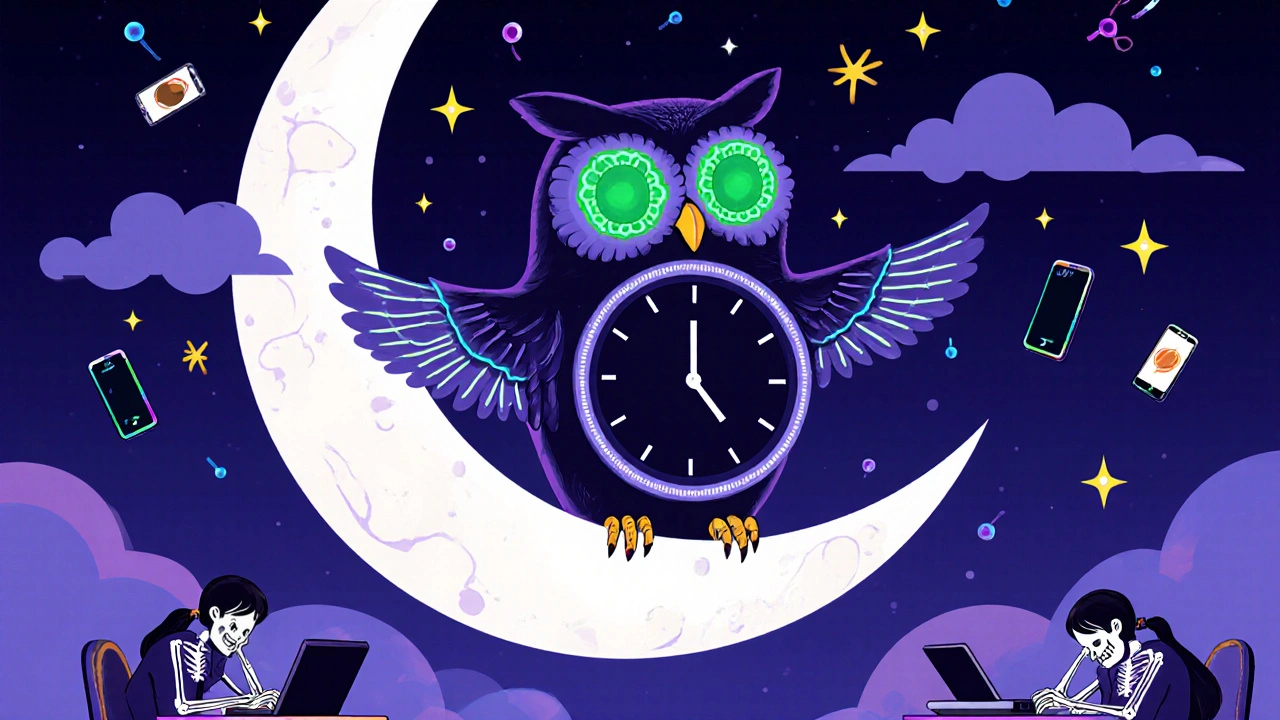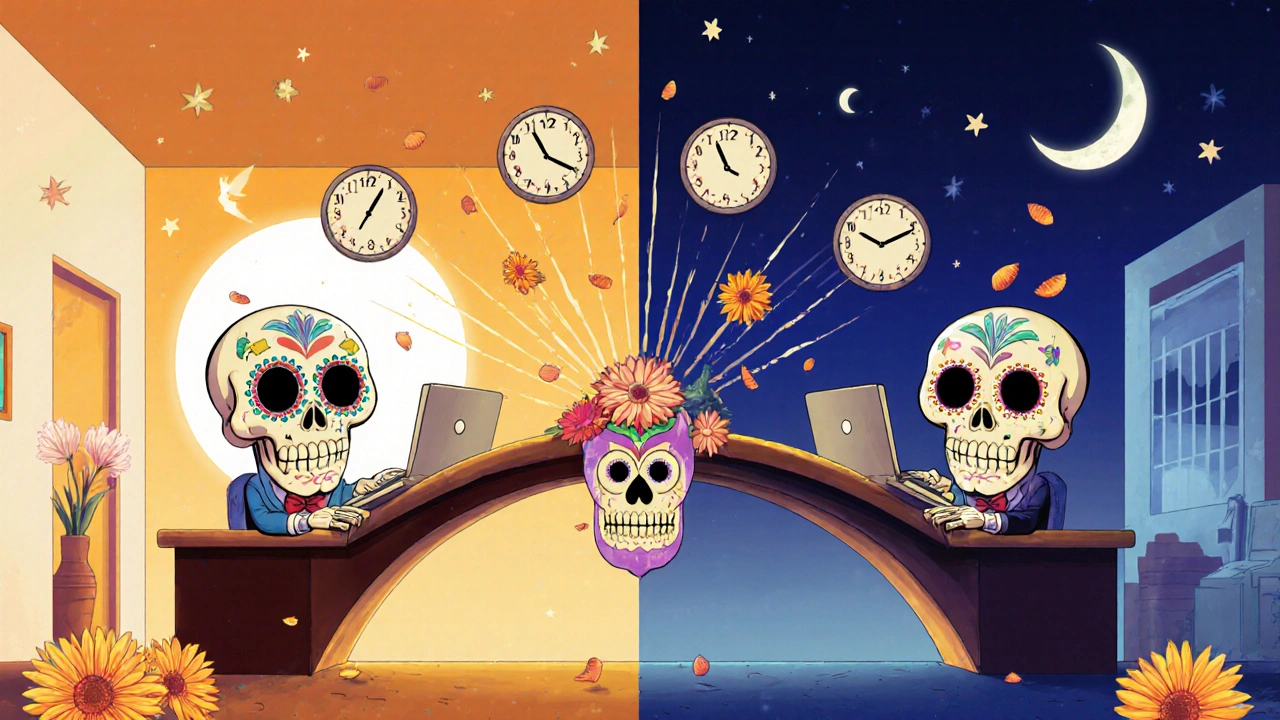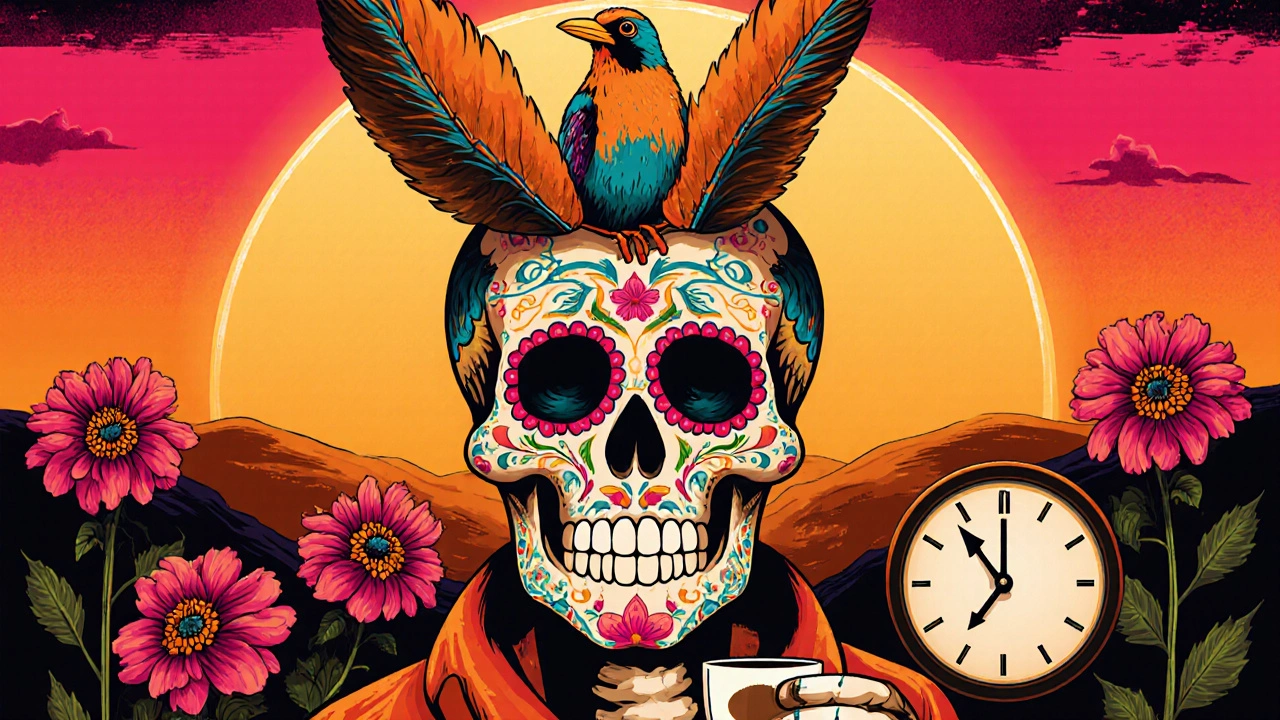Most people think being a morning person or a night person is just a matter of preference. But it’s not. Your chronotype is wired into your genes, shaped by light, and deeply tied to how your brain works - whether you realize it or not. If you’ve ever dragged yourself out of bed at 6 a.m. only to feel like a zombie until noon, or if you’re wide awake at 2 a.m. while everyone else is asleep, you’re not lazy. You’re just out of sync with the world’s clock.
What Exactly Is a Chronotype?
Your chronotype is your body’s natural rhythm for sleep and alertness. It’s not about willpower. It’s biology. Think of it like your internal thermostat - some people run hot in the morning, others peak at night. The science behind this goes back decades, but the real breakthrough came with the Munich ChronoType Questionnaire (MCTQ), developed by Till Roenneberg in the early 2000s. This tool measures your sleep midpoint - the exact middle of your sleep time on days when you don’t have to wake up to an alarm. That’s the key. Not when you go to bed. Not when you wake up. But the halfway point.
Most people fall somewhere between 11:30 p.m. and 8 a.m. for their sleep midpoint. But that’s just the average. Around 40% of people are morning larks - they wake up early, feel sharp by 7 a.m., and crash by 9 p.m. Another 30% are night owls - they don’t feel fully awake until after noon, and their best hours are after 8 p.m. The rest? They’re in between, and they’re the majority.
Why Your Chronotype Matters More Than You Think
It’s not just about when you feel tired. Your chronotype affects your memory, decision-making, mood, and even your long-term health. A 2023 study from Imperial College London found something surprising: among older adults, night owls actually scored higher on cognitive tests than morning larks. That flips the old belief that early risers are smarter or more productive. But here’s the catch - while owls might think better at night, they’re also at higher risk for serious health problems.
Research tracking over 430,000 people showed night owls had a 10% higher risk of early death compared to morning types. Why? Because they’re constantly fighting society. They’re forced into 9-to-5 jobs, early school starts, and social events that clash with their biology. The result? Chronic sleep deprivation. A 2020 analysis from BrainFacts.org found night owls are:
- 27% more likely to be obese
- 30% more likely to develop type 2 diabetes
- 25% more likely to have metabolic syndrome
- 29% more likely to suffer from depression
It’s not that being a night owl causes these problems. It’s that living against your body’s clock does.
The Hidden Cost of Being an Owl in a Lark World
College students tell the clearest story. Baylor University’s 2023 study tracked hundreds of students and found evening-type students slept 1.3 hours less per night than morning types - just 6.2 hours on average. They also napped more, drank caffeine later in the day (around 4:18 p.m. versus 1:27 p.m. for larks), and scrolled social media for 40 minutes in bed. Their sleep quality score was 23% lower. And their grades? They suffered.
One student, u/NightOwlStruggles on Reddit, summed it up: “As a software developer forced into 8 a.m. standups, I lose 3 productive hours daily fighting sleepiness.” That’s not laziness. That’s biological mismatch.
And it’s not just students. In healthcare, manufacturing, and transportation - industries with rigid shifts - 78% of evening chronotypes experience what scientists call social jet lag. That’s when your body’s clock is more than two hours off from your schedule. It’s like living in a different time zone every day. No wonder fatigue is so common.

Why Larks Have an Edge - And Why It’s Not Fair
Morning larks aren’t better people. They’re just better matched to the world. SleepWatch data from 10,000 users showed larks get 48 more minutes of sleep per night on average. They’re 40% more likely to wake up feeling rested. And 75% more likely to be women - a detail researchers still don’t fully understand.
They also report higher productivity in the morning. In SleepWatch’s survey, larks rated morning productivity at 4.7 out of 5. Night owls? Just 2.3. But flip the time - owls rated evening productivity at 4.8. Larks? 2.1. The data doesn’t lie: people perform best when their schedule matches their biology.
Can You Change Your Chronotype?
For years, scientists thought your chronotype was fixed. But new research says otherwise. Baylor’s 2023 study found that 28% of college students shifted their chronotype over a single semester - not by force, but by small, consistent changes.
You can adjust. It just takes time - usually 2 to 4 weeks. And you need to tackle three things:
- Light exposure: Get 10,000 lux of natural light within 30 minutes of waking. That’s about 20 minutes outside on a sunny day. If it’s cloudy, a light therapy box works too.
- Darkness at night: Keep your bedroom at 0-5 lux. No phone glow. No night lights. Even a tiny LED from a charger can disrupt melatonin.
- Caffeine cutoff: Stop coffee by 2 p.m. if you’re a lark. If you’re an owl, you might push it to 4 p.m. But after that, your body can’t process it fast enough to sleep well.
One study showed students who followed all three rules improved their sleep quality by 18%. And those who shifted from night owl to morning lark saw their GPA rise by 0.45 points on average.

What Workplaces Are Starting to Do
Companies are catching on. A 2023 Gartner survey found 42% of global organizations now offer flexible scheduling based on chronotype - up from 28% in 2020. Remote work made this easier. Sixty-seven percent of remote-first companies have flexible hours. Only 38% of office-based ones do.
Why? Because it works. When employees work during their peak hours, productivity jumps up to 18%. The market for chronotype-friendly tools - like scheduling apps, smart lighting, and wearable sleep trackers - is growing at 14.3% a year and could hit $2 billion by 2028.
Gen Z is driving this change. Pew Research found 52% of Gen Z workers identify as night owls. Baby Boomers? Only 31%. The future of work isn’t 9-to-5. It’s 10-to-6 for some. 12-to-8 for others.
How to Find Your Chronotype (And Use It)
You don’t need a lab test. Just track your sleep for a week - no alarms, no work, no guilt. When do you naturally fall asleep? When do you naturally wake up? That midpoint is your chronotype.
Here’s a simple rule:
- If your midpoint is before 3:30 a.m. → You’re a lark
- If it’s between 3:30 a.m. and 5:30 a.m. → You’re intermediate
- If it’s after 5:30 a.m. → You’re an owl
Once you know it, design your day around it.
- Larks: Schedule deep work in the morning. Save meetings for midday. Wind down by 9 p.m.
- Owls: Push meetings to after 11 a.m. Do creative work after 6 p.m. Avoid caffeine after 4 p.m. Get morning light even if you’re tired.
- Intermediate: You have flexibility. But don’t ignore your rhythm. If you feel sluggish at 8 a.m., don’t force it. Delay your start.
The Bottom Line
Your chronotype isn’t a flaw. It’s a feature. The problem isn’t you. It’s a world built for early risers, ignoring the fact that nearly a third of us are wired to be awake when the sun goes down.
You don’t have to become a morning person. But you do need to stop fighting your biology. Adjust your schedule. Protect your sleep. Demand flexibility when you can. And if you’re a manager, stop punishing night owls for being late to a 7 a.m. meeting. They’re not lazy. They’re just on a different clock.
The future belongs to people who work with their rhythm - not against it.


Paul Baker
November 29, 2025 AT 00:07Zack Harmon
November 30, 2025 AT 11:51Jeremy S.
November 30, 2025 AT 11:52Jordyn Holland
December 1, 2025 AT 00:15Jasper Arboladura
December 2, 2025 AT 10:13Joanne Beriña
December 2, 2025 AT 22:19ABHISHEK NAHARIA
December 3, 2025 AT 20:09Hardik Malhan
December 4, 2025 AT 19:53Casey Nicole
December 6, 2025 AT 11:38Kelsey Worth
December 7, 2025 AT 06:54shelly roche
December 8, 2025 AT 13:32Nirmal Jaysval
December 9, 2025 AT 14:11Emily Rose
December 10, 2025 AT 16:56Benedict Dy
December 11, 2025 AT 18:09Emily Nesbit
December 11, 2025 AT 20:43